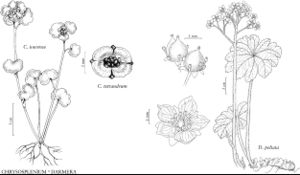Difference between revisions of "Darmera peltata"
Gärtn. Zentralbl. 1: 645. 1899,.
imported>Volume Importer |
imported>Volume Importer |
||
| Line 58: | Line 58: | ||
|publication year= | |publication year= | ||
|special status=Illustrated;Endemic | |special status=Illustrated;Endemic | ||
| − | |source xml=https:// | + | |source xml=https://bitbucket.org/aafc-mbb/fna-data-curation/src/2e0870ddd59836b60bcf96646a41e87ea5a5943a/coarse_grained_fna_xml/V8/V8_147.xml |
|genus=Darmera | |genus=Darmera | ||
|species=Darmera peltata | |species=Darmera peltata | ||
Latest revision as of 22:41, 5 November 2020
Leaves: petiole 20–150 cm; blade (5–)10–60(–90) cm wide. Inflorescences scapose, 30–150 cm, sparsely stipitate-glandular. Flowers: hypanthium saucerlike, 0.5–1 mm; sepals reflexed, rounded to oblong, 2.5–5 mm, apex rounded; petals spreading, broadly elliptic to obovate, unlobed, 5–9 × 4–4.5 mm; stamens 4 mm; styles divergent, 1 mm. Capsules 2, reddish, elliptic, 7–11 mm. Seeds 120–150, 1–1.5 mm. 2n = 34.
Phenology: Flowering Apr–Jul.
Habitat: Among wet rocks in and near streams
Elevation: 30-1800 m
Discussion
Darmera peltata is found in the Sierra Nevada of California from Tulare County to Siskiyou County and in the Klamath Mountains and Coast Range from Humboldt County in California to Benton County, Oregon. It is sometimes cultivated as an ornamental. Pregnant Karok women took an infusion of the roots of D. peltata to prevent the fetus from getting too large; Karok and Miwok Indians ate the plant (D. E. Moerman 1998).
Selected References
None.

